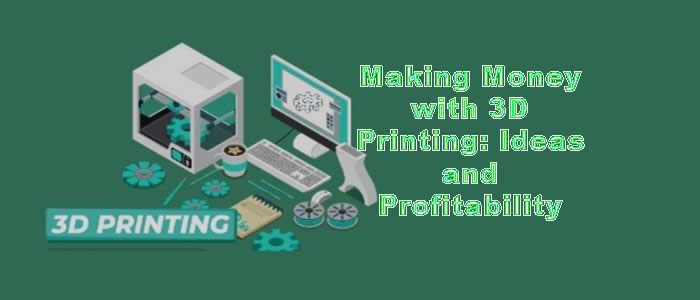
Over the past decade, 3D printing has transitioned from a niche technological innovation to a mainstream manufacturing tool. Its ability to produce complex, customized, and low-volume parts cost-effectively has opened up numerous entrepreneurial opportunities. For hobbyists, small business owners, and innovators alike, 3D printing offers a pathway to generate income and turn creative ideas into profitable ventures.
This article explores the various ways to make money with 3D printing, the potential profitability of different ideas, and practical tips for success in this exciting industry.
1. Understanding 3D Printing and Its Business Potential
3D printing, also known as additive manufacturing, involves creating three-dimensional objects layer by layer from digital models. With advancements in printer technology, materials, and software, small-scale 3D printers can produce high-quality items at a fraction of traditional manufacturing costs.
The flexibility and customization capabilities of 3D printing make it appealing for entrepreneurs looking to serve niche markets or develop innovative products. However, understanding the technology, costs, and market demand is crucial before diving into a 3D printing business.
2. Profitable Ideas for Making Money with 3D Printing
a. Custom Prosthetics and Medical Devices
One of the most impactful applications of 3D printing is in healthcare. Custom prosthetic limbs, dental implants, and surgical models can be produced at lower costs and with personalized precision.
Profitability: High, but requires compliance with medical standards and certifications. Initial investment may be significant, but the demand for personalized medical solutions is growing rapidly.
b. Jewelry and Fashion Accessories
Designing and printing unique jewelry pieces, fashion accessories, or even bespoke eyewear allows entrepreneurs to cater to clients seeking personalized style items.
Profitability: Moderate to high, especially with high-end or custom designs. Materials like resin or metal filaments can be costly, but customization commands premium prices.
c. Educational and Hobbyist Products
Educational institutions and hobbyists seek models, toys, and DIY kits. Creating educational tools, custom figurines, or hobby parts can be lucrative.
Profitability: Moderate, with potential for high volume sales. This niche benefits from low material costs and high demand for personalized or unique items.
d. Spare Parts and Replacement Components
Producing hard-to-find or obsolete parts for machinery, appliances, or vintage items can save customers money and time.
Profitability: Variable; depends on complexity and demand. Niche markets for vintage or specialized equipment often have less competition.
e. Architectural Models and Prototypes
Architects and product designers need accurate, detailed models for presentations and testing.
Profitability: High, especially for detailed, high-quality prototypes. This requires precision printers and skilled modeling.
f. Customized Promotional Items
Businesses often seek unique giveaways, branded figurines, or custom awards.
Profitability: Moderate; depends on order size and customization level. High-margin products can be created with branded or limited-edition items.
g. Art and Sculptures
Artists can create sculptures, installations, or limited-edition art pieces.
Profitability: Variable; depends on artistic reputation and uniqueness. Limited editions and commissions can command premium prices.
3. Assessing Cost and Profitability
To ensure a profitable 3D printing business, careful calculation of costs and pricing strategies is essential.
Costs to Consider:
- Printer Investment: Entry-level printers range from $200–$1,000; professional models cost more.
- Materials: Filaments, resins, and powders vary in cost; high-quality materials cost more but yield better results.
- Post-processing: Finishing, painting, or assembling items add labor costs.
- Design Software: Free options exist, but advanced CAD tools may require subscriptions.
- Labor and Time: Factor in your hourly rate and time spent on each project.
Pricing Strategies:
- Calculate the cost per item, including materials and labor.
- Add a profit margin based on market rates.
- Consider value-based pricing for custom or niche products.
Profit Margins:
- Jewelry and art items can have margins of 50% or more.
- Medical devices and prototypes may have lower margins but higher value per sale.
- Volume sales of low-cost items can generate steady income.
4. Marketing and Selling Your 3D Printed Products
Effective marketing is vital for success. Consider these channels:
- Online Marketplaces: Etsy, eBay, Amazon, or specialized craft sites.
- Your Website: Create an e-commerce store showcasing your portfolio.
- Social Media: Platforms like Instagram, Pinterest, and Facebook help showcase your work.
- Local Markets and Events: Craft fairs, art shows, or trade expos.
- B2B Sales: Partner with businesses, schools, or healthcare providers.
- Building a strong brand and demonstrating quality craftsmanship will attract repeat customers and referrals.
5. Challenges and How to Overcome Them
While profitable, 3D printing businesses face challenges:
- Initial Investment: Quality printers and materials can be costly. Start small and scale up.
- Learning Curve: Mastering design and printing requires time. Invest in training and tutorials.
- Quality Control: Consistent quality is crucial. Regular maintenance and calibration are necessary.
- Market Competition: Differentiate through unique designs, quality, and excellent customer service.
- Legal and Safety Regulations: Comply with standards, especially for medical or food-related products.
Overcoming these challenges involves continuous learning, investing wisely, and focusing on niche markets where you can excel.
6. Future Outlook and Trends
The 3D printing industry is poised for growth with innovations like multi-material printing, faster production speeds, and new sustainable materials. Emerging applications include bioprinting, construction, and aerospace.
Entrepreneurs who stay ahead of trends, adopt new technologies, and identify underserved markets can capitalize on these developments for long-term profitability.
Conclusion: 3D printing offers a versatile and profitable avenue for entrepreneurs willing to invest time and resources into mastering the technology. Whether you're creating customized jewelry, replacement parts, educational models, or art, the potential to generate income is vast. Success depends on understanding your target market, managing costs, and delivering high-quality products. With careful planning and innovative thinking, making money with 3D printing can turn your creative ideas into thriving business ventures. Embrace the technology, explore niche markets, and watch your entrepreneurial dreams take shape layer by layer.







 Optimus Bank USSD Code - How To Use It
Optimus Bank USSD Code - How To Use It  Top 20 Banks In Australia
Top 20 Banks In Australia